Invented by Ofer Hermoni, Nimrod Sandlerman, Eyal Felstaine, Amdocs Development Ltd
In recent years, artificial intelligence (AI) has become an integral part of various industries, revolutionizing the way businesses operate. AI systems rely on vast amounts of data to learn and make accurate predictions. However, the accuracy and reliability of these systems heavily depend on the quality of the data they receive. One critical challenge in this regard is the presence of falsified log data, which can significantly impact the performance and trustworthiness of AI-learning systems.
Falsified log data refers to intentionally manipulated or fabricated information that is fed into an AI-learning system’s training data. This can be done for various reasons, such as to deceive the system, manipulate its predictions, or exploit vulnerabilities. The consequences of using falsified log data can be severe, leading to biased or inaccurate AI models, compromised security, and unreliable decision-making.
Recognizing the importance of addressing this issue, a market for systems, methods, and computer programs for mitigating falsified log data has emerged. These solutions aim to detect, prevent, and mitigate the impact of falsified log data on AI-learning systems, ensuring the integrity and reliability of the data used for training.
One approach to mitigating falsified log data involves the use of advanced anomaly detection techniques. These techniques analyze patterns and behaviors within the log data to identify any inconsistencies or abnormalities that may indicate falsification. By flagging suspicious data points, AI systems can filter out or give less weight to potentially compromised information, reducing the impact of falsified log data on the learning process.
Another method involves the implementation of robust data validation and verification mechanisms. These mechanisms ensure that the log data received by AI-learning systems is authentic and has not been tampered with. By employing cryptographic techniques, digital signatures, or blockchain technology, the integrity of the log data can be verified, providing a reliable foundation for AI model training.
Additionally, the market for mitigating falsified log data has seen the development of computer programs specifically designed to detect and counteract various types of falsification techniques. These programs utilize machine learning algorithms to learn from historical data patterns and identify potential signs of falsification. By continuously adapting and updating their models, these programs can stay ahead of evolving falsification methods, ensuring the ongoing protection of AI-learning systems.
The demand for systems, methods, and computer programs for mitigating falsified log data is expected to grow rapidly in the coming years. As AI becomes more prevalent across industries, the need for reliable and trustworthy AI models will become paramount. Organizations will increasingly invest in solutions that can safeguard their AI systems from the risks associated with falsified log data.
Furthermore, regulatory bodies and industry standards are likely to play a crucial role in driving the market for mitigating falsified log data. As concerns over data privacy, security, and ethical AI practices continue to rise, there will be an increased focus on ensuring the integrity and transparency of AI-learning systems. Compliance with regulations and adherence to best practices will drive the adoption of solutions that mitigate falsified log data.
In conclusion, the market for systems, methods, and computer programs for mitigating falsified log data provided to an AI-learning system is poised for significant growth. As the reliance on AI continues to expand, organizations will prioritize the integrity and reliability of their AI models. By investing in solutions that can detect, prevent, and mitigate the impact of falsified log data, businesses can ensure the trustworthiness and accuracy of their AI systems, enabling them to make informed decisions and drive innovation in the AI landscape.
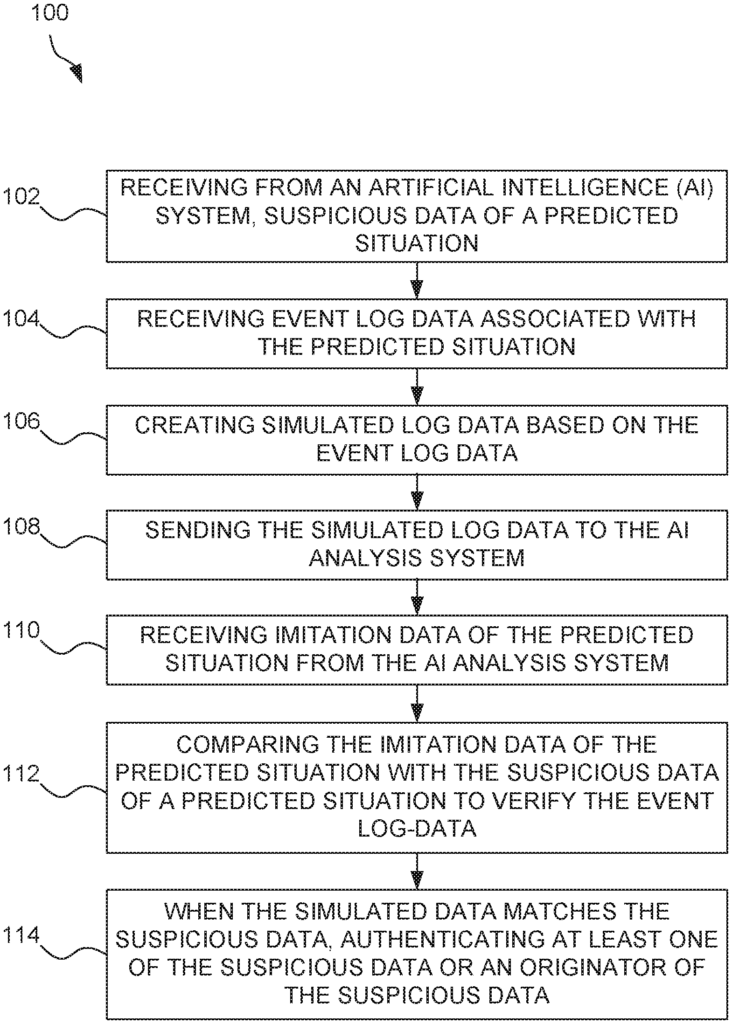
The Amdocs Development Ltd invention works as follows
A system, a method, and a computer program are provided for mitigating false log data supplied to an AI-learning systems. A system of artificial intelligence (AI), which analyzes data, receives suspicious data about a predicted scenario. Aside from the event log data, a predicted situation can also be received. Based on the log data, simulated log data is generated. The simulated log is sent to an AI analysis system. The AI analysis system sends the simulated data for the predicted situation. To verify event log data, the imitation data is compared to the suspicious data. “When the fake data matches with the suspicious data, the originator or at least one of the suspicious information is authenticated.
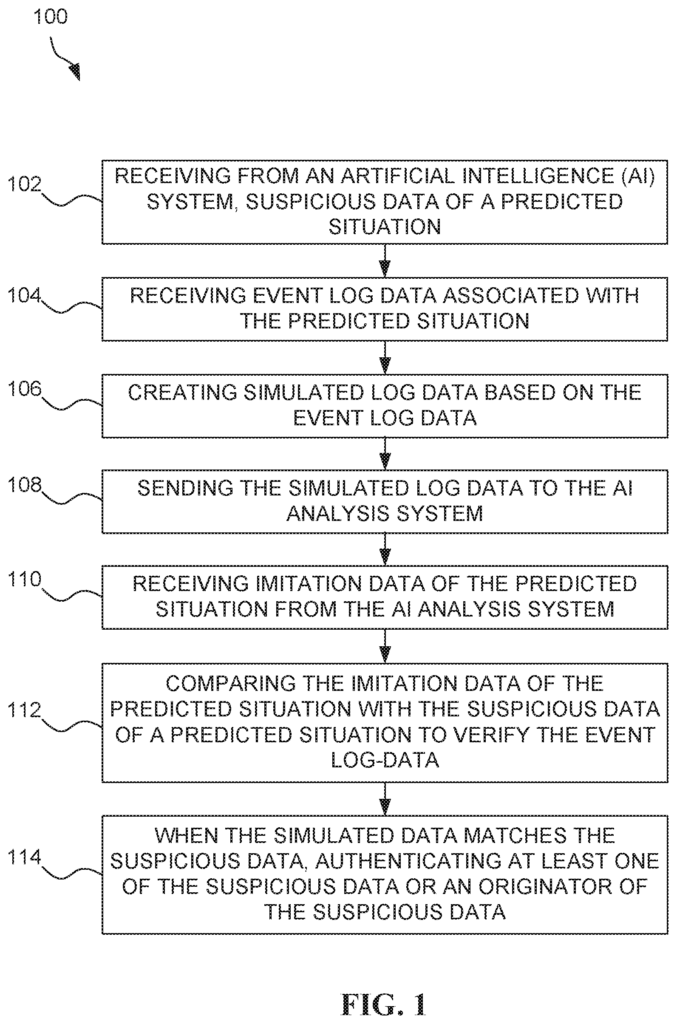
Background for System, Method, and Computer Program for Mitigating Falsified Log Data Provided to an AI-Learning System
Log data produced by a network monitoring system is then processed as input data by an AI-based system for network management. The AI-learning engine first processes the log data in the form training data and test data to produce the analysis rules. The AI-analysis engine then analyzes real-time logs in real-time to determine classifiers, and if the network needs to be reconfigured. The log data can be considered a vulnerability in the AI-based management system. Log data can be compromised by malware software that hacks software or firmware to report events to the monitoring software. Malware software may also hack the monitoring system which produces the log data. This hacking can affect the training data that is provided to AI-learning systems, or the log data that is provided to real-time AI analyses.
There is a need to address these and/or any other issues related to the prior art.
A system, a method, and a computer program are provided for mitigating false log data supplied to an AI-learning systems. A system of artificial intelligence (AI), which analyzes data, receives suspicious data about a predicted scenario. Aside from the event log data, a predicted situation can also be received. Based on the log data, simulated log data is generated. The simulated log is sent to an AI analysis system. The AI analysis system sends the simulated data for the predicted situation. To verify event log data, the imitation data is compared to the suspicious data. “When the fake data matches suspicious data, the originator or at least one suspicious data is authenticated.
A modern public digital communication network provides many communication-related services to a very large number of customers where each customer may use a variety of services. Each service can be used in different ways by each customer. In one embodiment, business needs may change rapidly for many customers, which may affect the way in which communication services are used. Business dynamics (and in particular increasing business dynamics), as well as network dynamics and network services, can be affected by business dynamics.
A purpose of Network Function Virtualization is to implement as much functionality of the network over a generic PC. Virtual(ized) network functions (VNFs) can therefore be instantiated anywhere on the network based on a cluster/network of generic computers. The ability to instantly create VNFs allows for network functions to migrate throughout the network. This may then lead to network reconfiguration. Fast migration and reconfiguration of the network can also save money on both capital expenditures (CAPEX), and operational expenses (OPEX).
In the context of this description, the word ‘cost’ can refer to any type of expenditure (such as associated with increased capital expenditure (CAPEX) and/or increased operational expenditures (OPEX)), as well as decreased revenues or a limitation on revenue increase. Any type of expense (such as increased capital expenditures (CAPEX) and/or increased operating expenditures (OPEX), as well as reduced revenues or a restriction on revenue growth, may be referred to. OPEX can include, in one embodiment, the cost of electricity used to power any network entities and/or to dissipate any heat generated by any network entities. OPEX can also include payments to third parties for the use of any hardware or software, such as processing power, storage and transmission.
Furthermore, in the context described here, the term service configuration is used. A network configuration that is applicable to a specific service may be referred to as a “service configuration”. This particular service can be requested or proposed by a specific customer (referred to here as the’requesting party’). For a certain time period, location, or business structure. A service configuration can be applied to an entire base or subsets of communication networks.
For example instead of planning the network based on a worst-case scenario (such as the highest expected cumulative demand), CAPEX could be reduced by planning it more accurately according to a time-dependent, optimized configuration. Then, OPEX costs can be cut in low-demand periods by moving the VNFs into a central location and closing down data centers that are not being used. This cost-saving may be one of the driving forces behind NFV. “Fast and effective reconfiguration may be a crucial element in the evolution and growth of NFV.
Also, the ability of network operators to reconfigure their networks quickly (and at a cost-effective price) could enable them to introduce new services more quickly, reduce the time to market, and lower onboarding costs. Customers can also request a limited-time service, such as a SLA, or place a demand shortly before the actual use of a particular service. Fast and automatic reconfiguration can reduce time and costs of business between network operators and software service providers, and/or consumers.
The network can be expected to adapt continuously to the flow of service requests by optimizing and reconfiguring it. A network configured to optimize performance may be one that is close to the maximum capacity it can provide while still providing all services required (based on SLAs or other forms of service requirements). The network configuration can be altered as the demand (in real-time) changes. This may include adding or removing hardware (e.g. turning it on or off), or migrating, instantiating or removing virtual networking functions (VNFs).
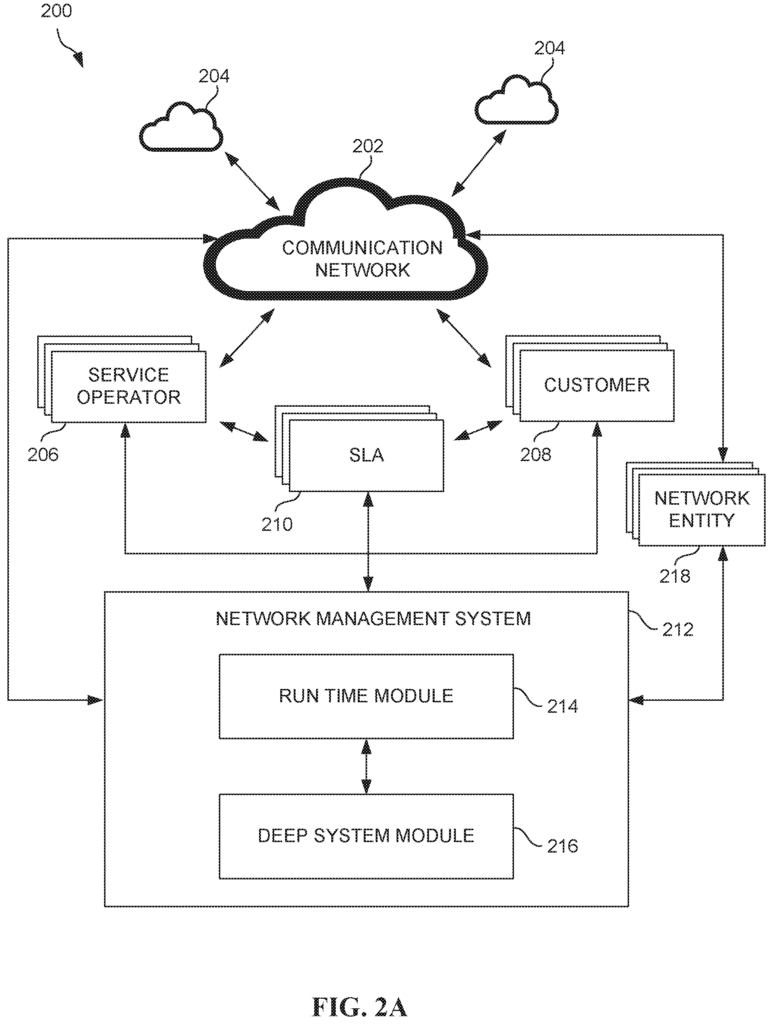
The network management system must be able predict situations that require network reconfiguration in advance, so the network can compute and implement the optimal new configuration before the need actually arises. Artificial intelligence (AI), due to the complexity of the network and the rapid change in demand, may be needed to meet this technical requirement.
The network management system can be used to manage a data network or a telecommunications network. It is also able to use artificial intelligence to do so.
FIG. According to one embodiment, FIG. 1 shows a method 100 of mitigating false data in log data. Falsified data is any data that may be misleading. In one embodiment, misleading data can include data that’s been altered.
As demonstrated, a system of artificial intelligence (AI), receives suspicious data about a situation that is predicted. Operation 102. The term “suspicious data” is used in the context of this description to describe any data which has not been validated. In different embodiments, this data can include an identity or a source. In one embodiment of the suspicious data, it may be data that has been flagged. The flags could include data patterns, a potentially dangerous source (e.g. IP address, known suspects sender, etc.), or malicious code. ), detected malicious code, etc.
Additionally event log data associated to the predicted situation are received.” See operation 104. In one embodiment, event log data can include critical parameter data. On the basis of event log data, simulated logs are created. “See operation 106.
In addition, simulated log data will be sent to the AI Analysis System.” See operation 108. In one embodiment, simulated log data can be used by AI analysis system to generate the imitation data for the predicted situation. In one embodiment, a comparison may be used by the AI analysis system to modify one or several monitoring rules. The AI analysis system may also associate the one or two monitoring rules with a confidence level. Modifying may also include creating a new rule for monitoring, deleting a rule that is already in place, or modifying the parameter of one or more rules.
Furthermore the AI analysis system receives imitation data of the predicted scenario.” Operation 110. To verify the log data, the fake data is compared to the suspect data. See operation 112. See operation 112. In another embodiment of verifying, each log event in the event log data may be labeled with authentication data. In another embodiment, verification may include linking each event log log to the sender, the linking being encrypted.
When the fake data match the suspect data, the originator or at least one of those suspicious data is authenticated. See operation 114. In one embodiment, the authentication may be used to reconfigure the network. In another embodiment, authenticating can include checking the event logs associated with the predicted scenario. In one embodiment, if the fake data does not match with the suspicious data then the suspicious data can be labelled as false. When the imitation data doesn’t match the suspicious data the suspicious data can be removed from the network in real time. When the fake data does not match with the suspicious data the suspicious data can be ignored. When the fake data is not the same as the suspicious data, it may also be possible to issue a report on a security breach.
FIG. 2A shows a communication system and a network management system according to one embodiment. The network management system may, at your option, be implemented within the context of one or more embodiments described in previous and/or following figures and/or descriptions. The network management system may, of course, be implemented within any desired environment. The definitions above can also be applied to the description given below.
In one embodiment, the management system for a network of communication networks using artificial intelligence may be described as a “communication network with AI”.
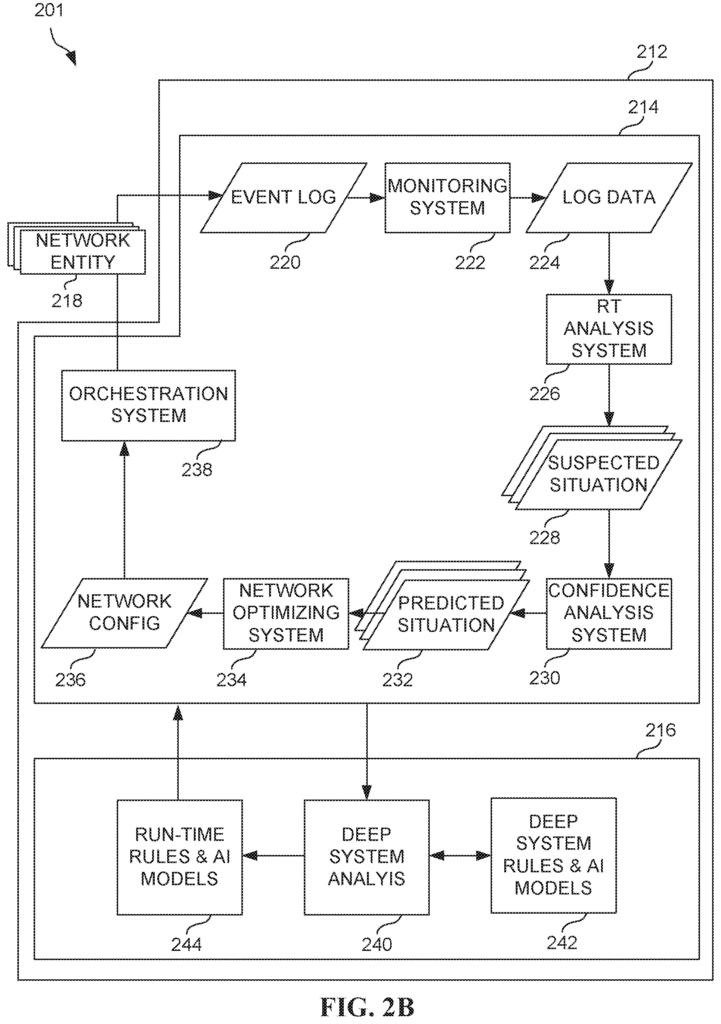
As shown, the system includes a communication system 202, one of more secondary networks, a management system 212, including a runtime module 214, and a deep systems module 216. In one embodiment, one or more of the secondary networks 204 can be connected to the communication network.
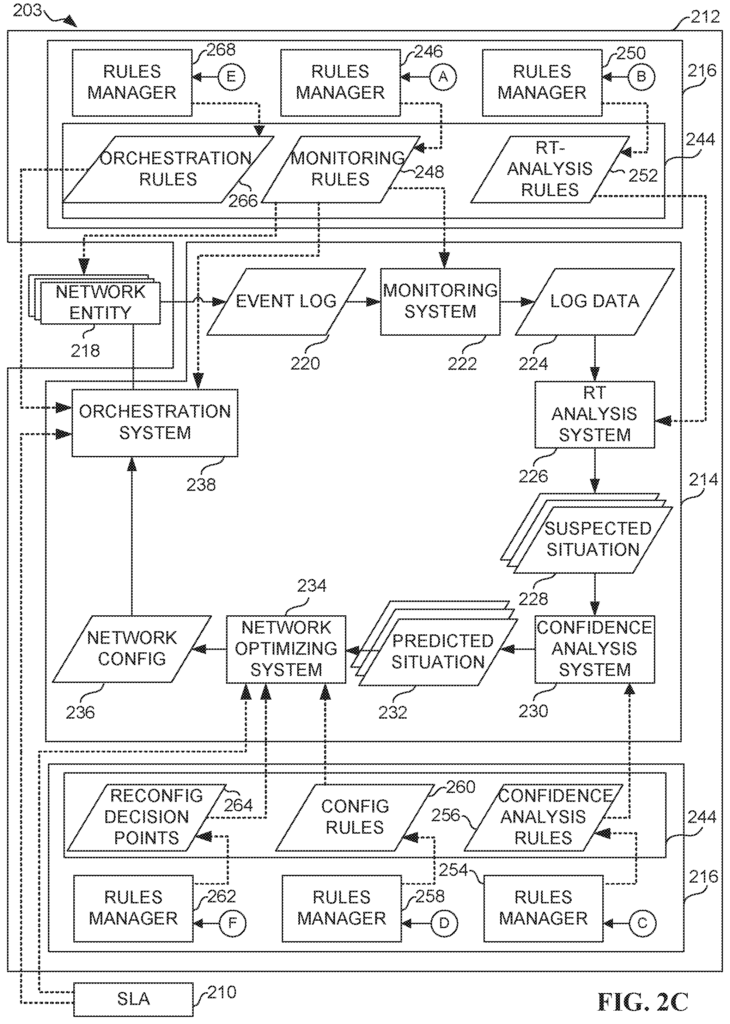
Click here to view the patent on Google Patents.
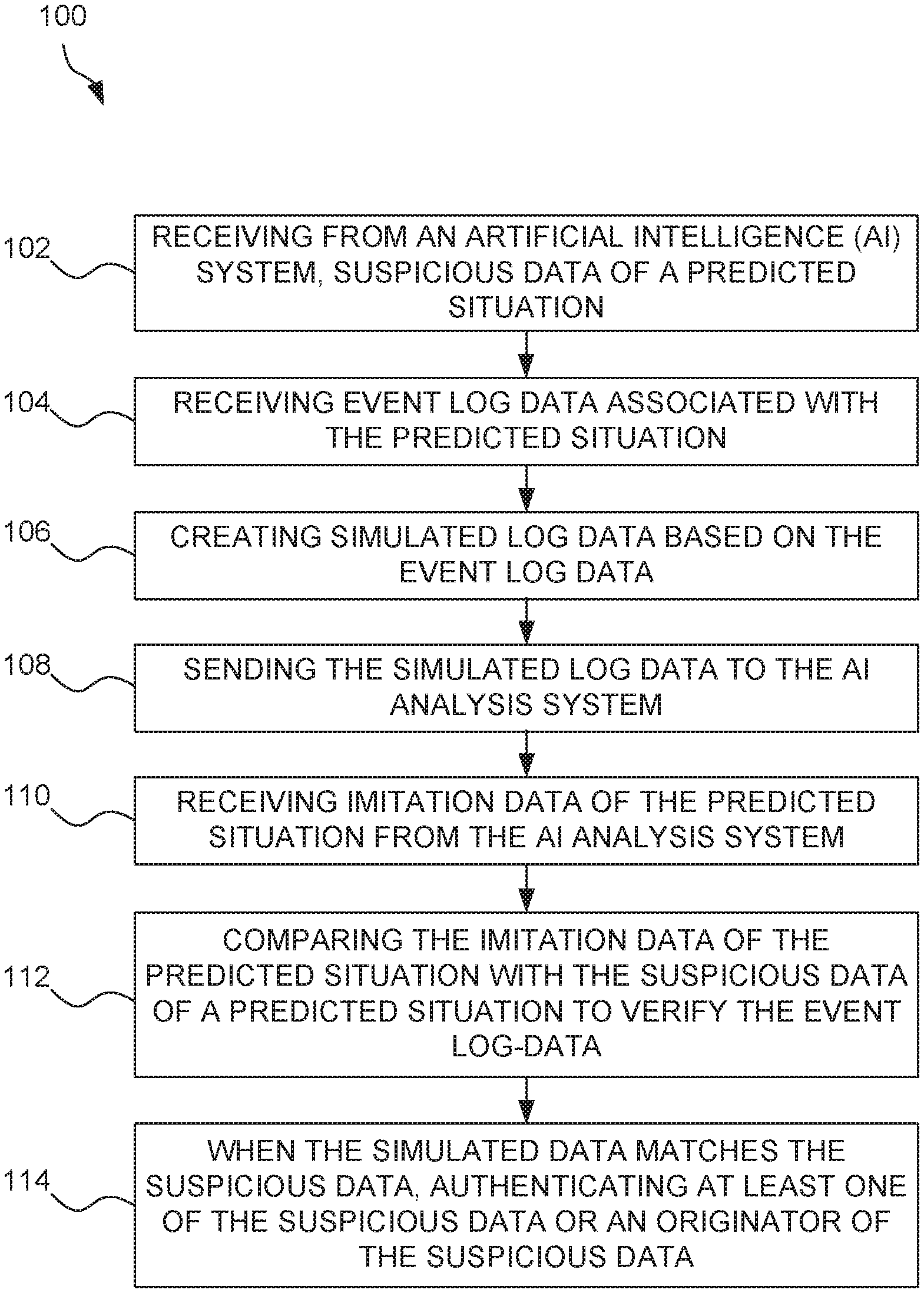
Leave a Reply